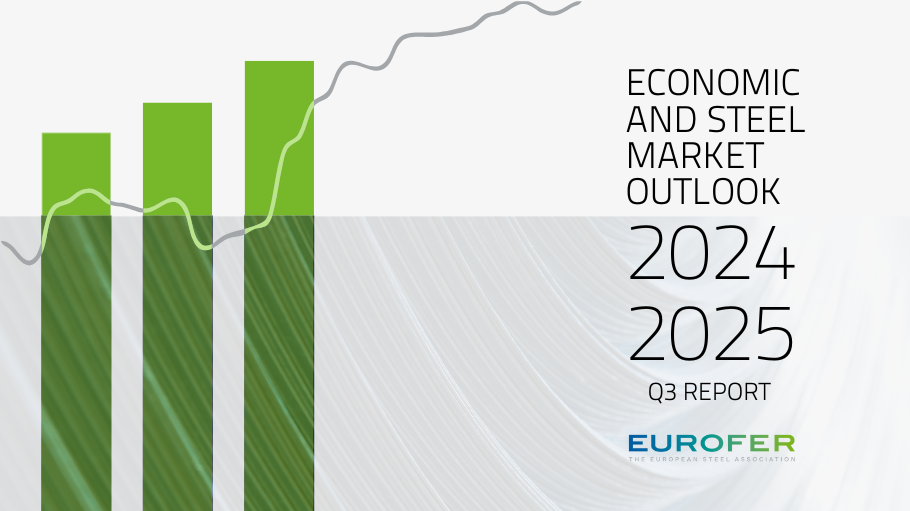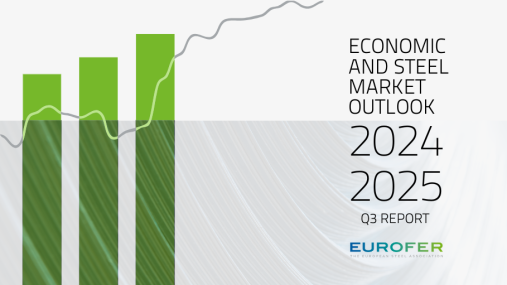
Publications » Economic and market outlook » Economic and steel market outlook 2024-2025, third quarter
Economic and steel market outlook 2024-2025, third quarter
Downloads and links
Recent updates

The negative trend in the steel market observed in the first half of 2023 has persisted and become more acute over the last three quarters. The severe consequences of the war in Ukraine and the deteriorating manufacturing outlook, along with the overall economic environment, continued to take their toll. Apparent steel consumption in the EU decreased (-3.1%) in the first quarter of 2024, after a rise (+2.9%) in the preceding quarter which was mainly due to the comparison with the very low volumes seen one year earlier. After a significant recession (-8.3%) in 2022, persistent downside factors such as ongoing conflicts, uncertainty surrounding energy prices and inflation combined with a worsened economic outlook, have further negatively impacted apparent steel consumption in 2023. The data reveal a more pronounced contraction (-9%) compared to 2022, marking the fourth annual recession in the last five years.
This downward trend is set to also impact the anticipated rebound for this year. In 2024, conditional on more favourable developments in the industrial outlook and increased steel demand, apparent steel consumption is projected to recover at a lower rate than previously estimated (+1.4% vs. +3.2%). The overall evolution of steel demand remains subject to very high uncertainty. Moderate quarterly improvements in apparent steel consumption are expected to continue throughout 2024, although volumes are still expected to remain below pre-pandemic levels.
In the first quarter of 2024, apparent steel consumption dropped (-3.1%), following an increase in the preceding quarter (+2.9%), which was largely due the comparison with very low volumes seen one year earlier. The total volume in the first quarter of 2024 stood at 31.9 million tonnes.
The current downturn in EU apparent steel consumption, reflecting poor demand conditions began in the second quarter of 2022, due to war-related disruptions, unprecedented rises in energy prices and production costs. Demand conditions worsened considerably during the second half of 2022, and this negative cycle continued until the fourth quarter of 2023, as a result of growing global economic uncertainty, high interest rates and overall manufacturing weakness.
Domestic deliveries mirrored developments in demand, contracting (-5.8%) after an increase (+1.3%) in the preceding quarter. In 2022, deliveries plummeted (-9.1%), reflecting the sharp deterioration in demand. As a result of protracted negative developments throughout the year, in 2023 domestic deliveries markedly dropped again (-4.6%).
Imports into the EU including semi-finished products increased (+12%) in the first quarter of 2024, following a similar rise in the preceding quarter (+11.3%). It is also worth noting that the drops in imports recorded in the previous quarters essentially reflected weak demand conditions. Therefore, the share of imports out of apparent consumption has remained considerably high in historical terms throughout 2023 and up to the first quarter of 2024, reaching 27%.
In the first quarter of 2024, the Steel Weighted Industrial Production index (SWIP) dropped (-1.9%) after a marginal increase (+0.5%) in the previous quarter. EU steel-using sector’s output had continued to grow, albeit at a slower pace, showing unexpected resilience despite the prolonged impact of Russia’s invasion of Ukraine, overall manufacturing weakness, global geopolitical tensions, and above-average energy prices.
The latest developments in the SWIP index were a combination of a continued downturn in the construction, mechanical engineering, domestic appliances and metalware sectors, only partly compensated by the continued growth in the automotive. The construction sector already entered recession in the third quarter of 2022 and saw its seventh consecutive quarterly drop (-2.3%, after -0.1% in the preceding quarter), and its recessionary trend is expected to continue throughout 2024. The positive trend in overall SWIP, which began after the pandemic, continued up to the fourth quarter of 2023, despite soaring energy prices impacting production costs, component shortages and lower output that starting to affect total production activity in steel-using sectors in the second half of 2022. The deterioration of the economic and industrial outlook in the EU – particularly due to high inflation and the subsequent interest rate hike by the European Central Bank (ECB) – had only a limited impact on steel-using sectors’ output up to the end of 2023. The construction sector, which accounts for 35% of steel consumption in the EU, was the only significant exception.
Ongoing economic uncertainty is set to continue taking its toll on growth in the upcoming quarters. The year 2024 is expected to be characterised by unpredictability, stemming from energy price levels, continued weakness in steel demand, inflation and interest rate-driven economic challenges.
The ongoing economic uncertainty is set to continue affecting steel market growth from the demand side over the upcoming quarters:
1. Despite EU industry proving quite resilient throughout 2023, the outlook for 2024 remains dominated by a worsening combination of uncertainties in energy prices, weak demand, inflation above target levels, severe geopolitical tensions and economic challenges driven by high interest rates, despite initial monetary easing.
2. While output grew more than expected (+3.2%) in 2022, SWIP growth in 2023 slowed down, achieving a higher-than- estimated growth (+1.2% vs. +1.1%), albeit with wide differences among individual EU economies and industrial sectors.
3. In 2024, growth in steel-using sectors is projected to drop (-1.6%, previously set at -1%), due to the second recession in a row in the construction sector, persistent geopolitical tensions, and the lagged impact of high interest rates on the overall manufacturing sector. Moderate growth is expected to resume moderately (+2.3%) in 2025.

Download this publication or visit associated links
Developed with the support of the Offshore Wind Foundation Alliance and European Wind Tower Association, the position paper outlines the strategic importance of wind components for Europe’s green transition and calls for targeted measures to strengthen their role within the NZIA.
Brussels, 2 April 2025 - The latest data unveiled by the OECD in its meeting in Paris draw an extremely worrying picture, where global steel excess capacity is expected to grow from an estimated 602 million tonnes in 2024 to 721 million tonnes by 2027 – over five times the EU's steel production. The European steel industry - already severely hit by the spill-over effects of global overcapacity and the U.S. steel import tariffs - reiterates the crucial need for strict and effective EU post-safeguard measures to ensure its survival.
Brussels, 19 March 2025 – The Steel and Metals Action Plan, unveiled today by the European Commission, provides the right diagnosis to the existential challenges facing the European steel industry. Concrete measures need to follow swiftly to reverse the decline of the sector, re-establish a level playing field with global competitors, and incentivise investment and uptake of green steel in the market.